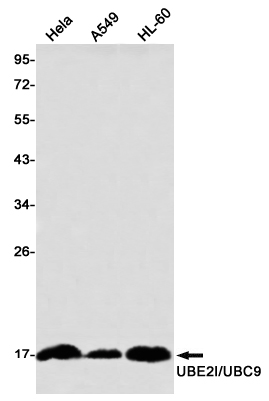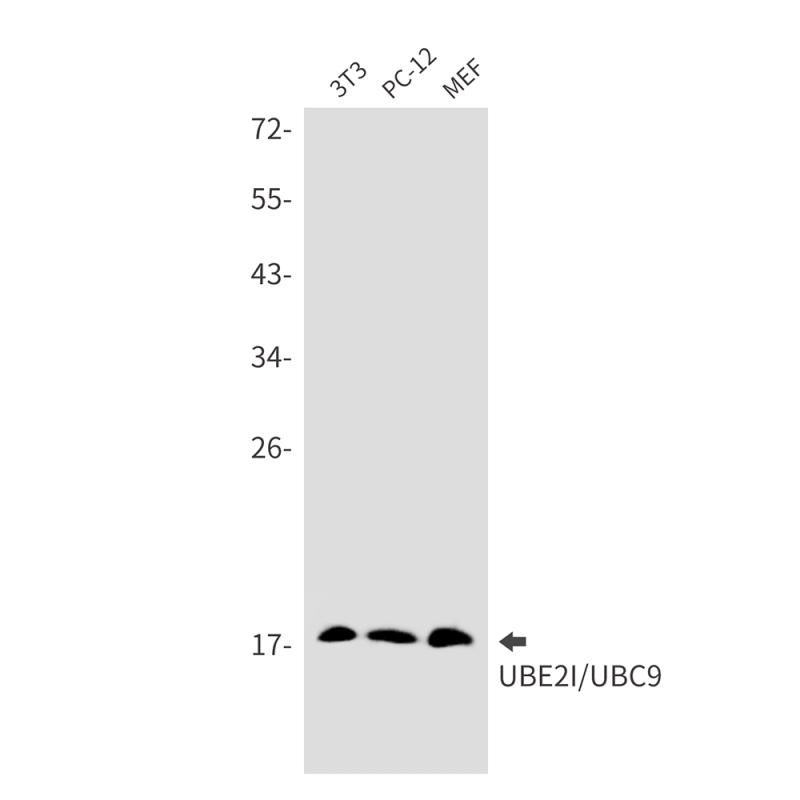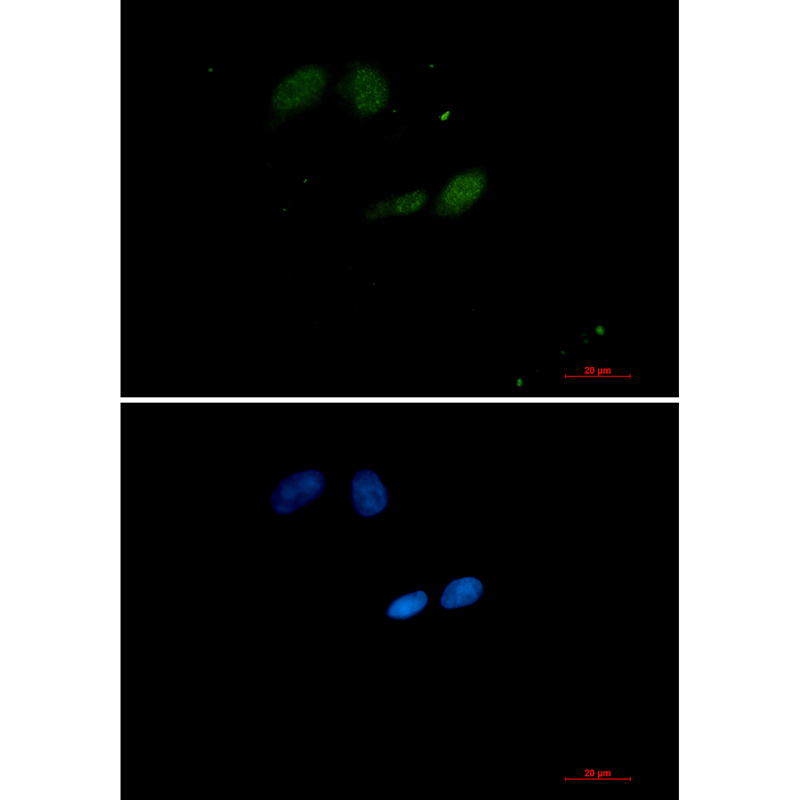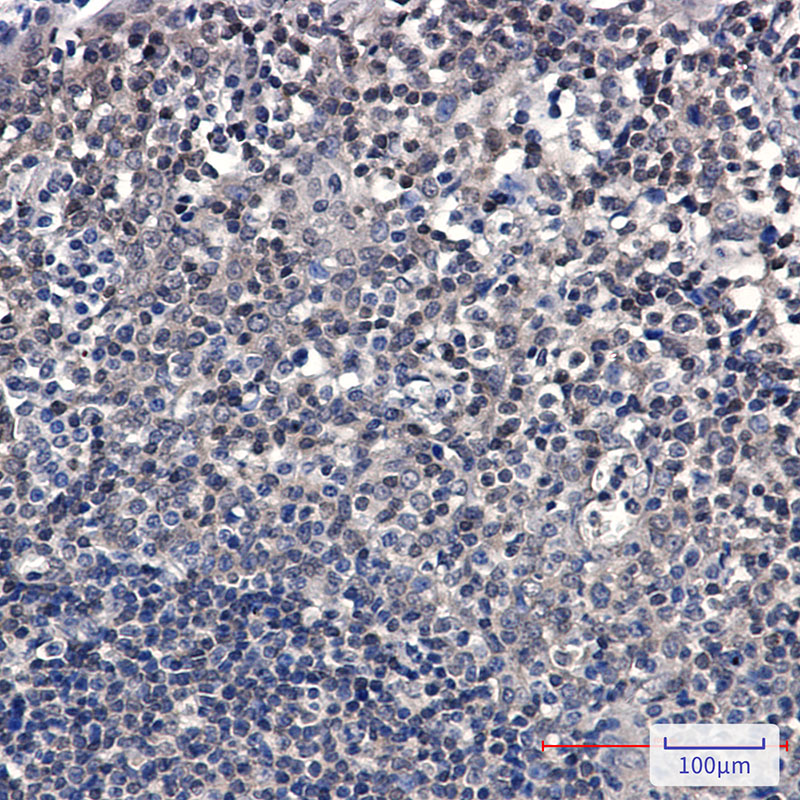



| WB | 1/500-1/1000 | Human,Mouse,Rat |
| IF | 1/20 | Human,Mouse,Rat |
| IHC | 1/50-1/100 | Human,Mouse,Rat |
| ICC | 1/50-1/200 | Human,Mouse,Rat |
| FCM | 咨询技术 | Human,Mouse,Rat |
| Elisa | 咨询技术 | Human,Mouse,Rat |
| Aliases | UBE2I; UBC9; UBCE9; SUMO-conjugating enzyme UBC9; SUMO-protein ligase; Ubiquitin carrier protein 9; Ubiquitin carrier protein I; Ubiquitin-conjugating enzyme E2 I; Ubiquitin-protein ligase I; p18 |
| Entrez GeneID | 7329 |
| WB Predicted band size | Calculated MW: 18 kDa; Observed MW: 18 kDa |
| Host/Isotype | Rabbit IgG |
| Antibody Type | Primary antibody |
| Storage | Store at 4°C short term. Aliquot and store at -20°C long term. Avoid freeze/thaw cycles. |
| Species Reactivity | Human,Mouse,Rat |
| Immunogen | A synthetic peptide of human UBE2I/UBC9 |
| Formulation | Purified antibody in TBS with 0.05% sodium azide,0.05%BSA and 50% glycerol. |
+ +
以下是关于SUMO Conjugating Enzyme UBC9抗体的3篇参考文献(虚拟示例,非真实文献):
1. **文献名称**:*"A Monoclonal Antibody Specific for SUMO-Conjugating Enzyme UBC9 Reveals Dynamic Localization in Cell Nucleus"*
**作者**:Zhang et al.
**摘要**:本研究开发了一种针对UBC9的单克隆抗体,验证其特异性并应用于免疫荧光和Western blot分析,揭示了UBC9在细胞核内的动态定位及其与SUMO化修饰的关联。
2. **文献名称**:*"UBC9 Expression Correlates with Tumor Progression: An Immunohistochemical Study Using a Novel Polyclonal Antibody"*
**作者**:Lee et al.
**摘要**:通过新型多克隆抗体检测UBC9在多种癌症组织中的表达,发现其高表达与肿瘤转移和不良预后显著相关,提示UBC9作为潜在癌症生物标志物的价值。
3. **文献名称**:*"Characterization of SUMOylation Machinery in Neurodegenerative Diseases: Role of UBC9 Antibody in Detecting Pathological Aggregates"*
**作者**:Smith et al.
**摘要**:利用UBC9抗体研究阿尔茨海默病和帕金森病患者脑组织中的SUMO化修饰,发现UBC9在病理蛋白聚集物中的富集,提示其参与神经退行性病变的分子机制。
(注:以上为模拟生成内容,实际文献需通过PubMed、Google Scholar等平台以关键词“UBC9 antibody”或“SUMO conjugating enzyme antibody”检索。)
**Background of SUMO Conjugating Enzyme UBC9 Antibody**
The SUMO conjugating enzyme UBC9 (Ubiquitin Carrier Protein 9), encoded by the *UBE2I* gene, is a critical component of the SUMOylation pathway, a post-translational modification system analogous to ubiquitination. UBC9 functions as an E2 conjugating enzyme, directly transferring small ubiquitin-like modifier (SUMO) proteins to lysine residues on target substrates, often in coordination with E3 ligases. This modification regulates diverse cellular processes, including nuclear transport, transcriptional regulation, DNA repair, and cell cycle progression.
Antibodies targeting UBC9 are essential tools for studying SUMOylation dynamics. They enable the detection and quantification of UBC9 expression levels in various biological samples via techniques like Western blotting, immunofluorescence, and immunohistochemistry. Additionally, these antibodies facilitate co-immunoprecipitation assays to explore UBC9’s interactions with substrates or regulatory proteins.
UBC9 dysregulation has been implicated in diseases such as cancer, neurodegeneration, and cardiovascular disorders, making its study clinically relevant. For example, elevated UBC9 levels in certain cancers correlate with enhanced SUMOylation of oncoproteins, promoting tumor progression. Researchers also use UBC9 antibodies to investigate its role in stress responses or viral infections, where SUMOylation modulates host-pathogen interactions.
When selecting UBC9 antibodies, specificity validation is crucial to avoid cross-reactivity with other E2 enzymes. Many commercial antibodies are raised against conserved regions of UBC9. ensuring recognition across species like humans, mice, and rats. These reagents are indispensable for dissecting the mechanistic and pathological roles of SUMOylation in cellular homeostasis and disease.
×